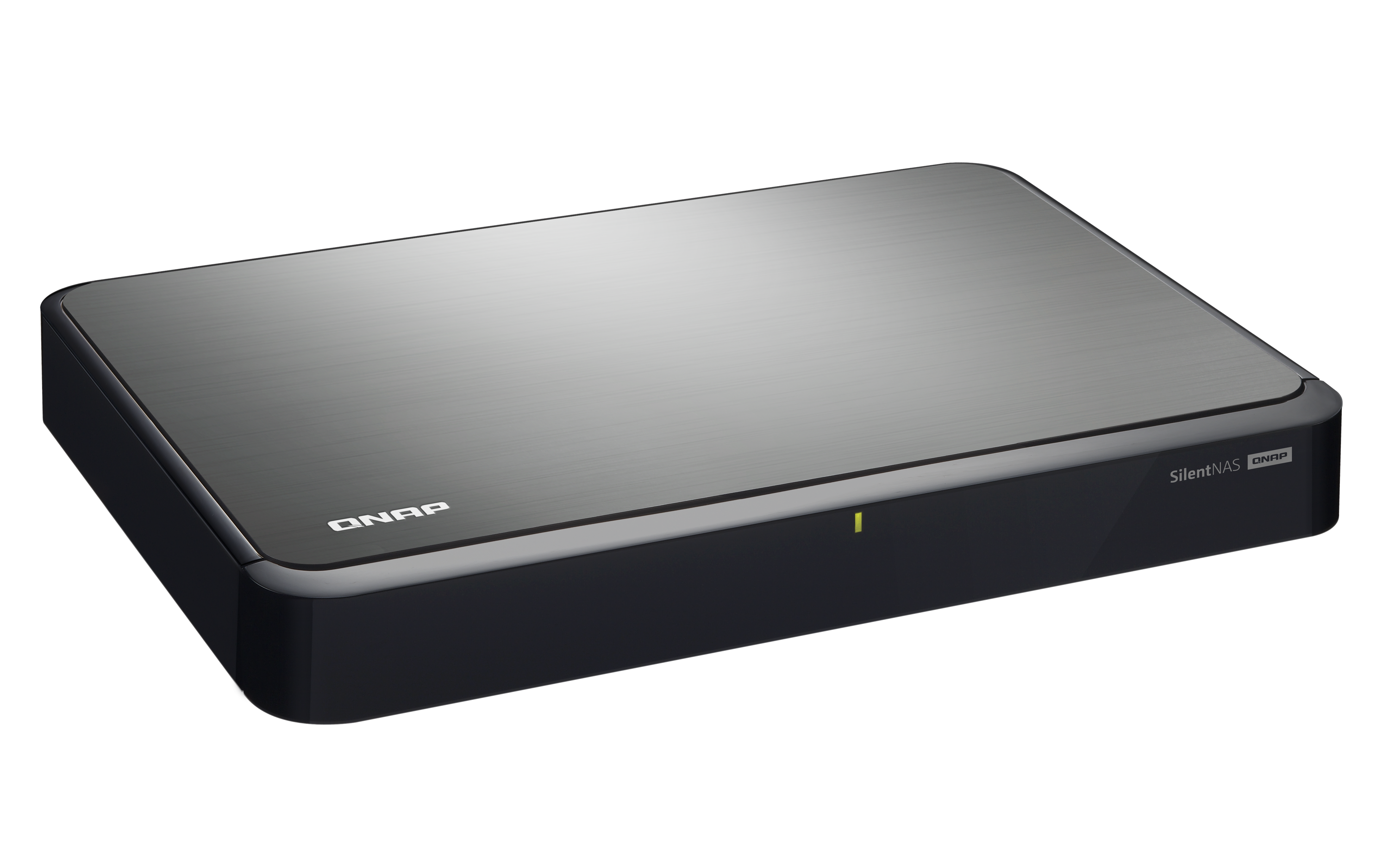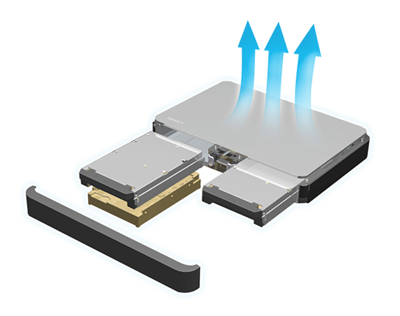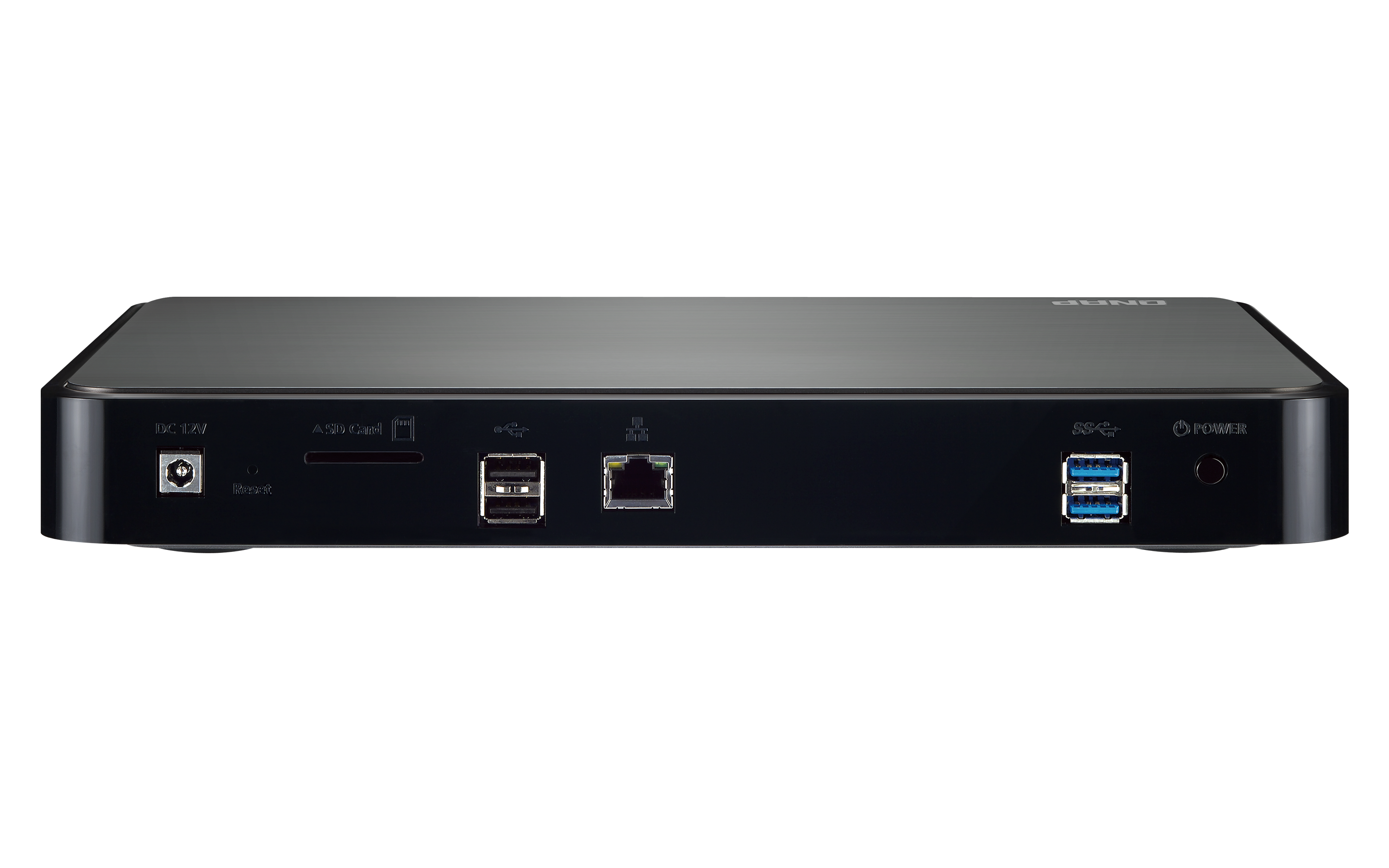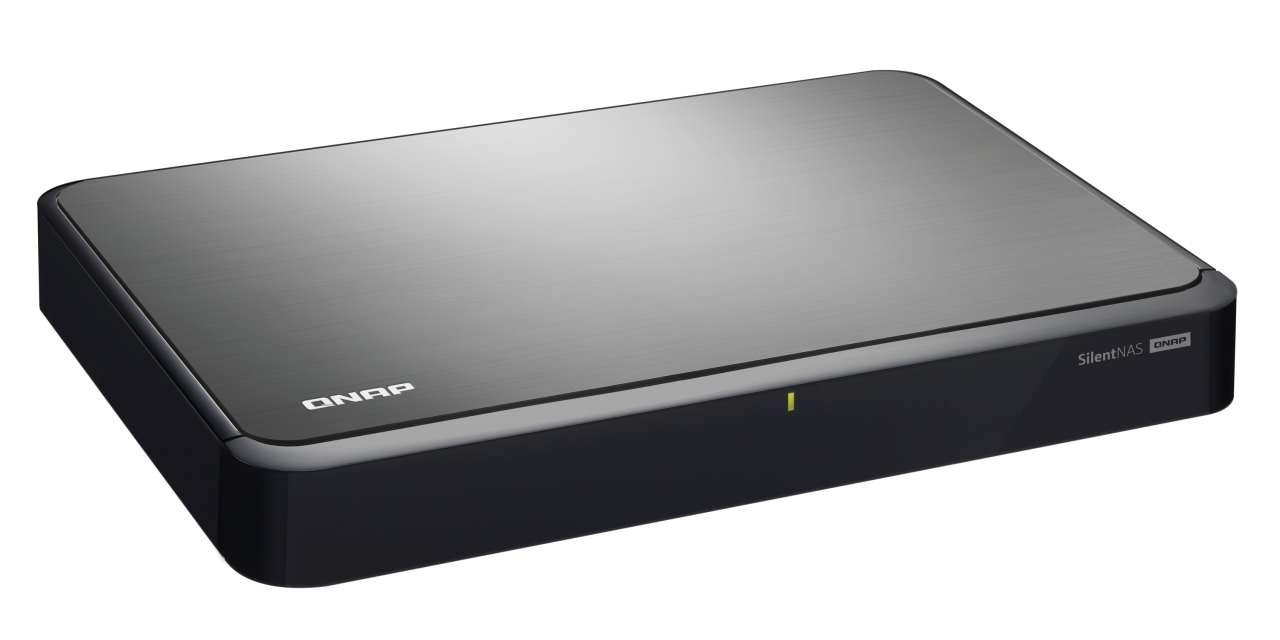 Early this year, QNAP launched a Network Attached Storage (NAS) specially designed for the modern digital lifestyle. With thanks to QNAP, the HS-210 has been on an extended tour of duty on the DigitalReviews test bench.
Early this year, QNAP launched a Network Attached Storage (NAS) specially designed for the modern digital lifestyle. With thanks to QNAP, the HS-210 has been on an extended tour of duty on the DigitalReviews test bench.
Let see what makes this NAS different.
First Impressions
The QNAP HS-210 is a two-bay slimline NAS that looks far from your standard NAS enclosure. For starters it has a brushed metal and aluminium body that is designed to blend in with the home entertainment system. A major selling point of the HS-210 is its fanless architecture – designed to serve up media to the entertainment system without the omnipresent fan noise.
Even without the hard drives in the unit, there is a surprising amount of weight to the chassis. It feels solidly constructed right down to the removable front panel which hides the drive bays. It snaps on and off with ease guided by a central magnet and does not feel like it will just dislodge.
The bays can accept either 2.5″ or 3.5″ drives, the caddies clearly indicates where to mount the respective drive sizes. In my case two Seagate NAS drives have been used to populate the HS-210, each drive requiring 4 screws to secure it to the caddy. With the drives in a side-by-side configuration, the HS-210 is a slim unit, about the height of a slimline DVD/BD player with a smaller footprint.
The front panel of the unit is very minimalistic. Around the back are the power jack, two x USB 2 and two x USB 3 ports, an Ethernet port and a SD card reader.
 Getting Started
Getting Started
If you are internet connected (and let’s face it in this market how many people are not these days?), simply point your browser to start.qnap.com and the Setup Wizard will take you through the steps. Alternatively you can scan the QR code embedded in the manual to set up via iOS or Android device. In reality, there are very few steps to get the HS-210 up and running with most things including downloading the latest firmware is done automagically.
Like all hard disk arrays, full synchronisation of volumes can take a while, depending on the array size, but it does not stop you from jumping right into using it. By default the unit sets up the drives in RAID1 configuration, there are a few more hoops to jump through if you want to set it up as a RAID0 array.
Once you are in, the GUI interface is clearly iOS influenced, or influenced by one of QNAP’s main competitors who themselves are iOS influenced. It has been a little while since I have worked with the QNAP GUI, but this latest revision looks far prettier and more intuitive to work with.
In Action
With the highly touted fanless design feature aimed at silent operations, the logical thing to do is to put the unit right next to my workspace right?
The fanless design takes away the whine of a sleeve bearing fan or the distinct sound of the ball bearing fan, but does it run silently? The answer lies between sort of and can be. It comes down to the drives you put into the chassis. I am old enough to remember the good old Quantum Fireballs with their thumping drive access drum beats. In the case of the HS-210, QNAP recommends the use of Seagate NAS or Western Digital Red drives to minimise the noise levels. In order to achieve near 100% silent operation (in relation to ambient noise), the choice is SSD or SSD. Based on QNAP’s laboratory test results, WD Red drives results in noise level around 15dB, SSD noise level is measured at less than 7dB.
The good part about a fanless design is that is does not suck dust into the system. Given how dusty it can get behind home entertainment systems, this is an excellent outcome.
Having homed the HS-210 next to my workspace, it was inevitably covered by paperwork. Periodically I would put my hand on top of the pile of paper and see how warm things get. The great news is that I did not start a fire, the good news is that the unit only ever has gotten warm and not hot. In fact, it is quite nice on a cold winter’s day to warm my hands on it. On the other hand, it would be best to keep the top surface unobstructed as it is clearly designed to dissipate the heat load in the absence of a fan.
Like all NAS these days, the fight is not so much over hardware specifications but features and functionalities. The QNAP operating system provides bucket loads of functions such as:
* Qfile – constant access to files including real-time backup of photos and AirPlay support for multimedia
* QManager – manage the HS-210 remotely
* QMusic – access your music collection by either streaming or download to a mobile deviice
* Notes Station – create digital notebooks in a private cloud, with ability to share to-do lists, calendars and notes with individuals or groups
* SocialLink Station – private social networking platform
just to name a few. There are plenty of third party applications that can be manually installed including the popular Plex media server.
Sample Use Case
Gone are the days when a NAS is purely used for storage. With everyone having a mobile device or two, or three, the NAS is the hub of centralising data for work, play and the all important backup. Yes it is easy to configure automated backup from a PC or Mac. For mobile users all those precious photos you have taken tends to stay on the phone (disclosure: I use the Google+ Auto Backup feature personally), but with the Qfile app you can set automatic back up of photos from your mobile device.
Connect your camera or video camera to the built-in USB ports and transfer the files directly to the HS-210.
Once the media is backed up to the QNAP, you could share it via Multimedia Center with DLNA or AirPlay. Depending on the configuration, one could set it to sync to a cloud service for an additional level of backup. Pretty handy!
With the Seagate NAS in place, the HS-210 can read a 10.03GB file across the LAN at around 45MB/s sustained, taking 3 minutes 44 seconds according to my tests. Writing the same file back across the LAN was around 53MB/s sustained, taking 3 minutes 3 seconds to transfer. Copying some 220MB of files ranging from a few hundred kilobytes to 42MB took a shade under 6 seconds reading, and writing was a fraction under 6 seconds. Pretty decent transfer rates!
 Other Features
Other Features
Video Station – a tool for playing your personal video collections online, with built in sharing with family or friends on social networking sites.
Photo Station – simplifying photo sharing with access control.
Music Station – to categorise your music collection and display album covers to easily organise your personal playlists as well as access Internet radio programs.
Backup – QNAP NetBak Replicator supports real-time and scheduled data backup on Windows, including Outlook email archiving, Apple Time Machine support for Mac OS X users, third party software support including Acronis True Image and Symantec Backup Exec.
QSync – Dropbox like file sync for all linked devices
myQNAPcloud – remotely access your HS-210 anywhere via web browser
File sharing – centralised data storage supporting SMB/CIFS, NFS and AFP protocols.
FTP Server – share large size files, with user-defined settings including bandwidth limitation, number of connections, and write-only permission.
Web Server – allows up to 32 websites on the single one Turbo NAS.
Printer Server – Supporting up to a maximum of 3 USB printers, the HS-210 supports IPP, Samba, print job management and Bonjour printing for Mac OS X.
Surveillance Station – Connect and manage multiple IP cameras remotely, including real-time monitoring, video recording, playback, and event notifications.
Notes Station – Enables users to create digital notebooks on the private cloud provided by the HS-210. Notes can be enrich with files, photos, music and video collection stored on the HS-210 and also create to-do lists, calendars and share their notes with individuals/groups.
SocialLink Station – A private social networking platform for the HS-210 that allows for absolute privacy. Users can share information & files without worries as the social network is owned by them. The invited member-only design ensures users have full control over the things they share on the SocialLink Station and the people who can access it.
Signage Station – Allows users to create multimedia-rich presentations for TV, tablets and smartphones, making it ideal for creating animated advertisements, menu boards, personal resumes and business profiles.
Gripes
Topping my short list of gripes with the QNAP HS-210 is the missing HDMI output port. For something designed to look the part next to the home entertainment system, to run silently and gear to deliver media, I cannot connect it for direct playback. Instead I need to put it where I have a LAN port, which for all I care, can be inside a cupboard. It has DLNA and AirPlay support, neither of which need the box to run silently and to look good. Which leads me to the next point.
Equipment will always generate heat. Unless you are going to shell out for a pair of SSDs, then the other option is good old mechanical drives which are neither silent nor cool when under load. Passive cooling on the HS-210 seems to work, I certainly have not had any issues with heat despite the abuse I have managed to put my review unit through. There remains an open question as to whether passive cooling for hard disks is a good thing or not. My system temperature runs at a steady 43°C, and my two Seagate NAS are at 37°C and 38°C respectively.
Specifications
CPU: 1.6GHz Marvell
Memory: 512MB DDR3
Flash Memory: 16MB
Hard Disk Drive: 2 x 3.5″ or 2.5″ SSD or NAS Hard Drives
Hard Disk Tray: 2 x Hot-swappable tray with lock
LAN Port: 1 x Gigabit RJ-45 Ethernet port
LED Indicator: Status, LAN
USB: 2 x USB 3.0 port, 2 x USB 2.0 port
SD Card Slot: 1
Buttons: Power, Reset
Alarm Buzzer: System warning
Form Factor: Set-top design
Dimensions: 41.3 x 302 x 220 (HxWxD) mm
Weight: Net 1.56kg, Gross 2.62kg
Power Consumption: Sleep mode: 7.39W, In Operation: 13.71W (with 2 x WD Red HDD installed)
Temperature: 0 – 40°C
Humidity: 5~95% RH non-condensing, wet bulb: 27˚C
Power Adaptor: External Power Adaptor, 60W, 100-240V
Conclusions
The QNAP HS-210 is a great little unit all round with good performance, the capability is extended by the applications available to perform specific tasks. No doubt the CPU was chosen to minimise heat footprint, but it still manages to be a decent performer though system operations will temporarily max out the CPU. It is important to keep in mind that the target market is not the power user demanding top transfer speeds, those users are unlikely to look at a 2 bay NAS to start with.
Despite the svelte presentation designed to reside in a lounge room, the missing HDMI output port relegates the unit to my bookshelf hidden away from view. There is absolutely no reason for me to put it near my home entertainment system in its current configuration. Overall it makes for a good centralised media storage solution, capability of consolidating media files from a variety of devices and connection methods, then sharing them to any number of destinations.
The QNAP HS-210 Silent NAS is available for around AUD$350, without drives.



